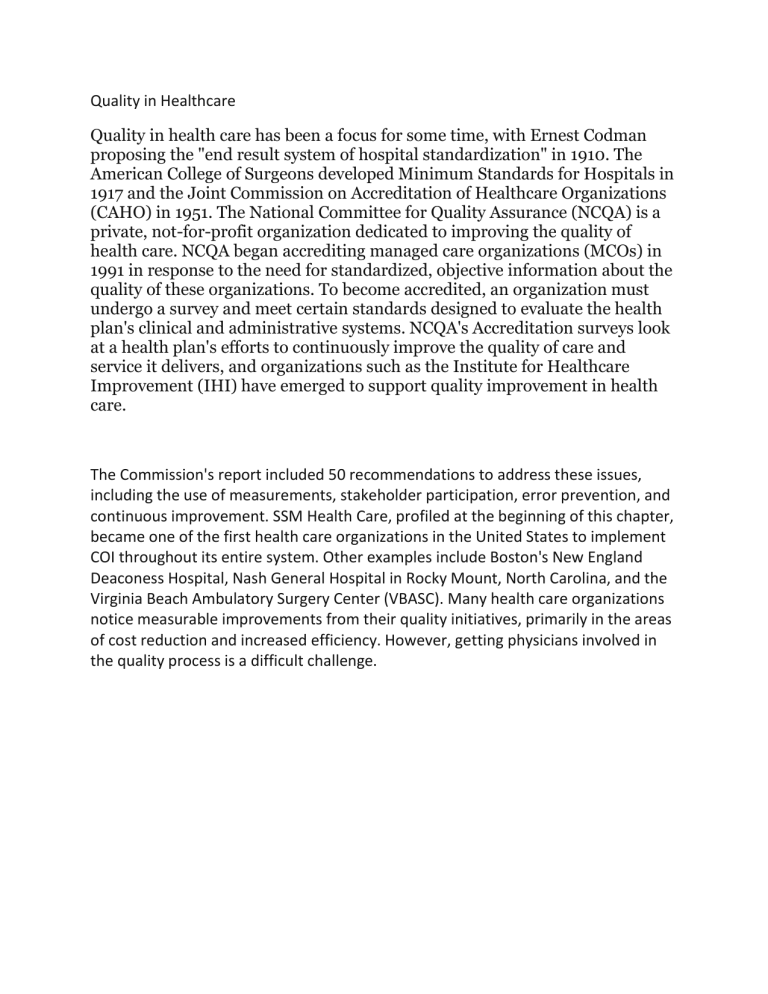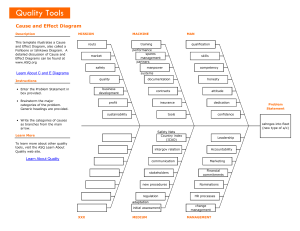
Quality in Healthcare Quality in health care has been a focus for some time, with Ernest Codman proposing the "end result system of hospital standardization" in 1910. The American College of Surgeons developed Minimum Standards for Hospitals in 1917 and the Joint Commission on Accreditation of Healthcare Organizations (CAHO) in 1951. The National Committee for Quality Assurance (NCQA) is a private, not-for-profit organization dedicated to improving the quality of health care. NCQA began accrediting managed care organizations (MCOs) in 1991 in response to the need for standardized, objective information about the quality of these organizations. To become accredited, an organization must undergo a survey and meet certain standards designed to evaluate the health plan's clinical and administrative systems. NCQA's Accreditation surveys look at a health plan's efforts to continuously improve the quality of care and service it delivers, and organizations such as the Institute for Healthcare Improvement (IHI) have emerged to support quality improvement in health care. The Commission's report included 50 recommendations to address these issues, including the use of measurements, stakeholder participation, error prevention, and continuous improvement. SSM Health Care, profiled at the beginning of this chapter, became one of the first health care organizations in the United States to implement COI throughout its entire system. Other examples include Boston's New England Deaconess Hospital, Nash General Hospital in Rocky Mount, North Carolina, and the Virginia Beach Ambulatory Surgery Center (VBASC). Many health care organizations notice measurable improvements from their quality initiatives, primarily in the areas of cost reduction and increased efficiency. However, getting physicians involved in the quality process is a difficult challenge. Quality in Education Education is a challenging area for quality improvement, and one of the earliest stories of the successful use of quality in education is that of Mt. Edgecumbe High School in Sitka, Alaska. David Langford, a teacher, brought the quality concepts to Mt. Edgecurnbe after hearing about them at a meeting at McDonnell- Douglas Helicopter Company. The students, with the coaching of Langford, used quality concepts to improve school processes, such as investigating the reasons for tardy classmates and reducing the average number of late occurrences per week. They also dropped the traditional grading system and instead used statistical techniques to keep track of their own progress. Eliminating grades has had a positive effect, with one student reporting that they found themselves learning a lot more. The Conroe Independent School District adopted a forward-looking strategic plan in 1993 that included a TQ implementation plan that relied heavily on training and teams. In 2001, two K-12 schools were among the first Baldrige Education winners: Chugach School District in Alaska and Pearl River School District in New York. In 2002, President Bush signed into law the No Child Left that has been proven to work, giving states and districts an annual report card to measure school performance and rate progress. A national survey of 401 public school principals by Harris Interactive and sponsored by the American Society for Quality (ASQ) found that U.S. elementary schools are more advanced than secondary schools in their use of quality tools and approaches. The majority of the principals surveyed (70 percent) believe that schools will be more likely to adopt quality improvement programs in the future. This is due to greater parental involvement at the elementary level. Additionally, 95% of principals report that their school has a school improvement plan that includes measurable outcomes, and eight in ten principals (81%) believe that improving standardized test score is extremely or very important. Despite these findings, principals are not as likely to measure their efforts in other areas that are important to them, such as improving teacher satisfac-tion and morale. Koalaty program The American Society for Quality (ASQ) has promoted quality in elementary education through the Koalaty Kid program. This program was an outgrowth of activities at Frederick C. Carder Elementary School in Corning, New York, where Fred the Koala appears throughout the schoolbulletin boards, at assemblies, in the cafeteria and in the classrooms. In the 1980s, several teachers identified areas of classroom errors and the principal identified factors that were most important to student success. To address these issues, the principal developed a Plan to bring about change throughout the whole school. Reading became a primary focus and students were invited to read books of their own choosing. Students were encouraged to read at home with system of contracts and incentives. Teachers communicated the standard of work they expected in home. In 1988, two ASQ members from Corning, Incorporated visited Carder School and learned about the parallels to total quality. The businesspeople brought the Carder model to the attention of ASQ headquarters, and the Society invested in a pilot program. A Koalaty Kid steering committee was formed to oversee the effort, and it began to emphasize a broader and more rigorous use of total quality in schools. More than 800 U.S. schools and many overseas have adopted the approach, and schools can utilize it to achieve their own objectives. Active Involvement is essential for the success of Koalaty Kid schools, where administrators, teachers, sponsors, parents, and students work together on teams that are empowered to make decisions and implement change. These teams represent a larger resource than the school's paid staff and can create change more swiftly and lastingly. Outside sponsoring organizations are also important to the success of the school, providing funds for quality training, expertise in troubleshooting quality processes, or enrichment for academic areas. Parent involvement is critical to the success, as they monitor homework assignments, read aloud, identify trouble spots, and communicate with students, teachers, and administrators about any factors that affect their children's success. Volunteers also help the school in a variety of ways, such as supplementing the work of classroom teachers with one-on-one tutoring, raising funds for needed equipment, and participating actively in decision making on the school's teams. Quality in Higher education


